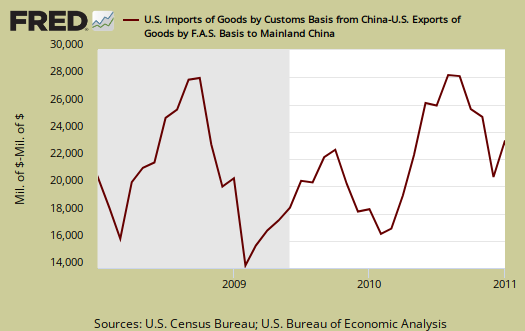The January 2011 U.S. trade deficit increased a whopping $6 billion to $46.3 billion, from the December 2010 trade deficit of $40.3 billion, revised. $26.7 billion of this deficit is oil related, $1.2 billion more than 1 month ago, and 45.3% of the total goods trade deficit. Imports increased 2.4 times faster than exports than December, with monthly increases of $4.4 billion for exports and imports $$10.5 billion.

Imports were 1.28 times larger than exports for January. In other words, for every dollar we export, we import $1.28 worth of stuff. This is on a Balance of Payments basis.
The United States basically has two major problems with the trade deficit, Chinese goods and Oil imports.
Below are imports vs. exports of goods and services from January 2007 to November 2010. Notice how much larger imports are than exports, but also notice the growth, or rate of change between months of U.S. exports.

Below is the list of good export increases from November to December. Industrial supplies includes oil and petroleum related products.
- Industrial supplies and materials: $3.69 billion
- Foods, feeds, and beverages: $0.08 billion
- Automotive vehicles, parts, and engines: $1.3 billion
- Capital goods: -$0.41 billion
- Cther goods: -$0.29 billion
- Consumer goods: -$0.55 billion
Exhibit 7 gives Census accounting method breakdown for exports. Autos had an astounding month.
Here are the goods import monthly changes:
- Industrial supplies and materials: $4.43 billion
- Capital goods: $2.1 billion
- Foods, feeds, and beverages: $0.49 billion
- Automotive vehicles, parts, and engines: $2.67 billion
- Consumer goods: $0.91 billion
- Other goods: -$0.56 billion
The above are seasonally adjusted. While rising oil prices will be blamed for the deficit, one can see, almost across the board, imports increased, not just oil.
On services, U.S. exports increased $0.5 billion while imports increase $0.4 billion for January. The advanced technology products trade deficit worsened.
Advanced technology products exports were $21.1 billion in January and imports were $28.3 billion, resulting in a deficit of $7.1 billion. January exports were $4.9 billion less than the $26.1 billion in December, while January imports were $3.3 billion less than the $31.6 billion in December.
Here is the breakdown with major trading partners, not seasonally adjusted. China is the worst trade deficit, with $23.3 billion, a $2.6 billion increase from last month. Oil is clearly back in play, terrorizing the economy, with a $1.6 billion increase in the OPEC trade deficit, now to $9.9 billion dollars.
OPEC, where the trade deficit is primarily oil, doesn't even compare to, less than half, the trade deficit with China.
The January figures show surpluses, in billions of dollars, with Hong Kong $2.2 ($2.2 for December), Australia $1.2 ($1.2), Singapore $0.8 ($1.3), and Egypt $0.5 ($0.7). Deficits were recorded, in billions of dollars, with China $23.3 ($20.7), OPEC $9.9 ($8.3), European Union $5.6 ($6.6), Japan $5.0 ($5.9), Mexico $4.9 ($4.7), Canada $3.7 ($3.9), Germany $3.1 ($3.3), Nigeria $2.9 ($2.5), Venezuela $2.8 ($2.0), Ireland $1.9 ($2.6), Korea $1.0 ($0.7), and Taiwan $0.9 ($0.6).
Below is the raw customs basis accounting of the trade deficit with China, not seasonally adjusted. China alone is 41.5% of the goods trade deficit for January. If one takes out oil, last month China was about 78% of the total not seasonally adjusted goods trade deficit. So, China trumps oil as a problem.

Below is a graph of trade deficit with China, per year. 2010 was a record for a trade deficit with China.

Here is Decembers's report (unrevised, although graphs are updated). Here is the BEA website for additional U.S. trade data.
You might ask what are these Census Basis versus Balance of Payment mentioned all over the place? The above mentions various accounting methods so we're comparing Apples to Apples and not mixing the fruit. The trade report in particular is difficult due to the mixing of these two accounting methods and additionally some data is seasonally adjusted and others are not. One cannot compare values from different accounting methods and have that comparison be valid.
In a nutshell, the Balance of Payments accounting method is where they make a bunch of adjustments to not count imports and exports twice, the military moving stuff around or miss some additions such as freight charges. The Census basis is more plain raw data the U.S. customs people hand over which is just the stuff crosses the border. The 2005 chain weighted stuff means it was overall modified for a price increase/decrease adjustment in order to remove inflation and deflation time variance stuff.
Bottom line, you want just the raw data of what's coming into the country and going out, it's the Census basis and additionally the details are only reported in that accounting format.

Recent comments